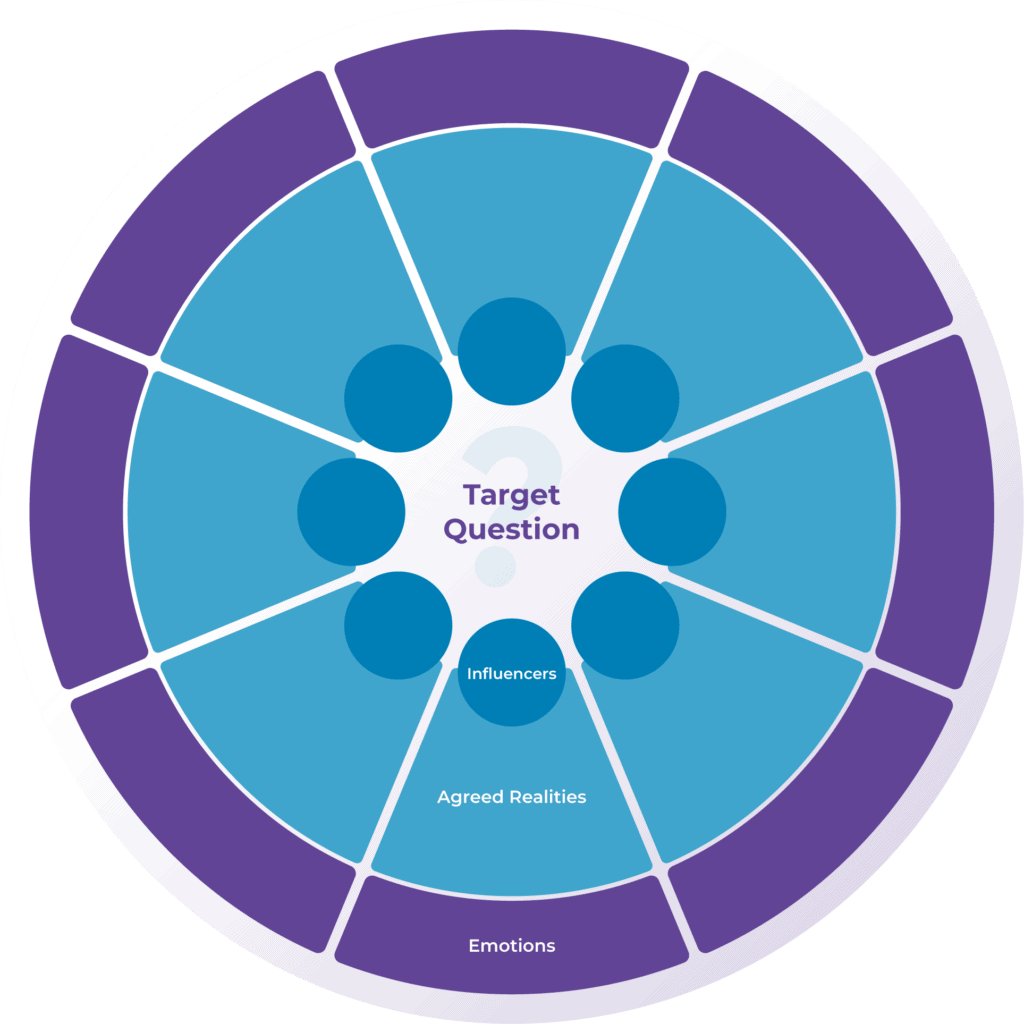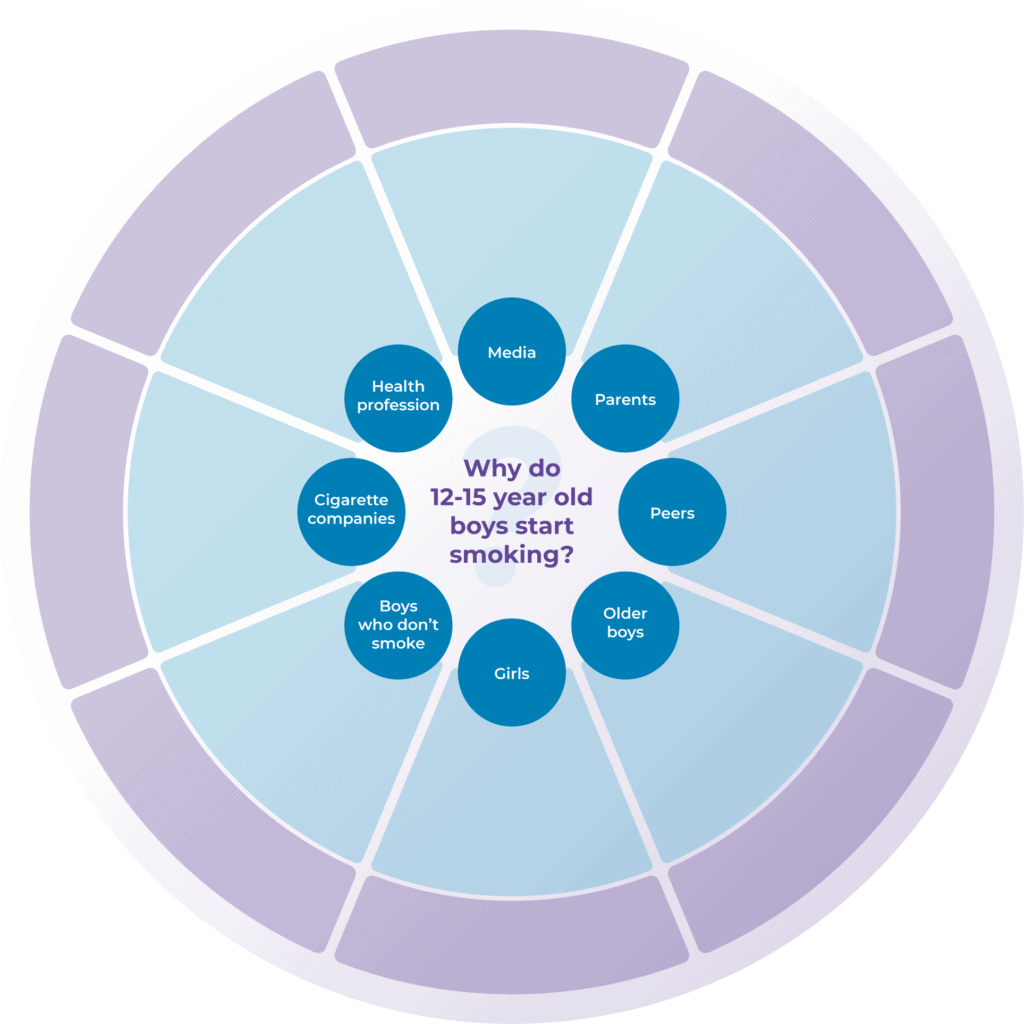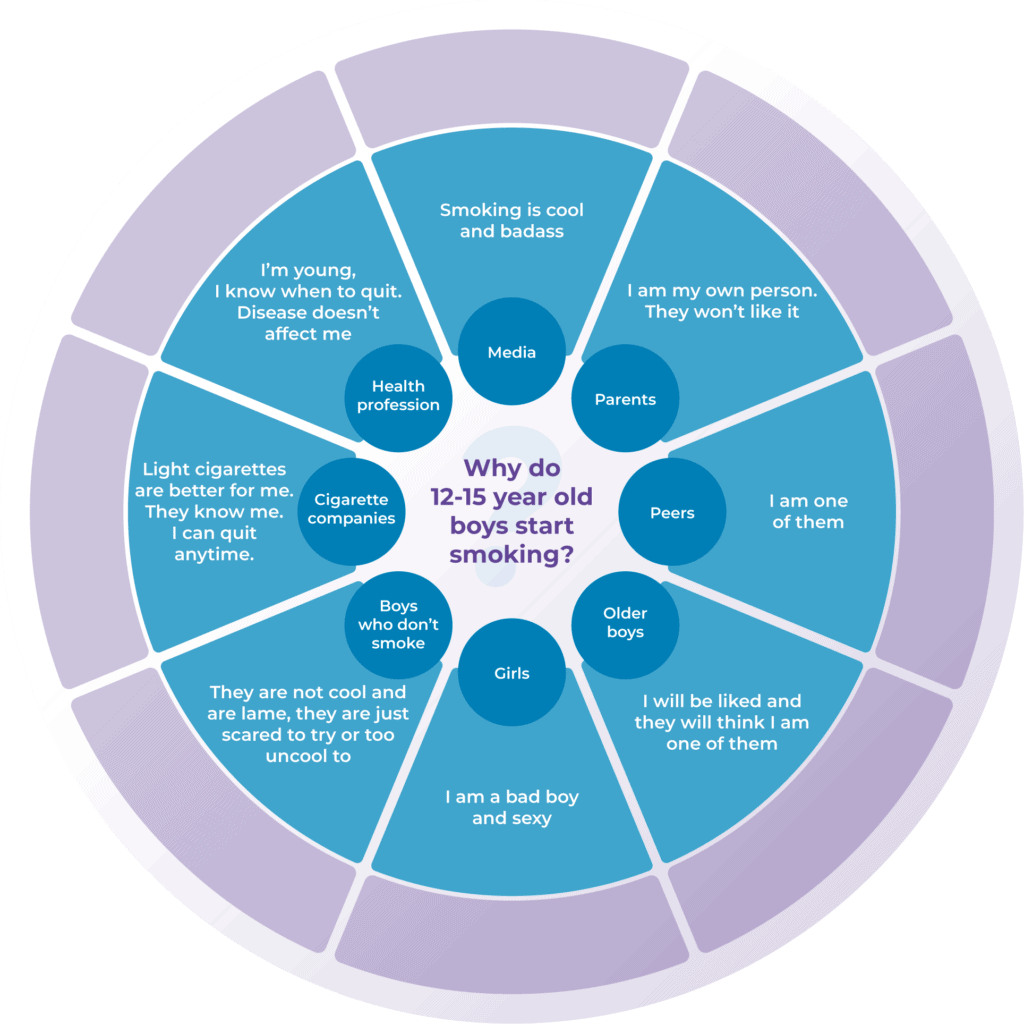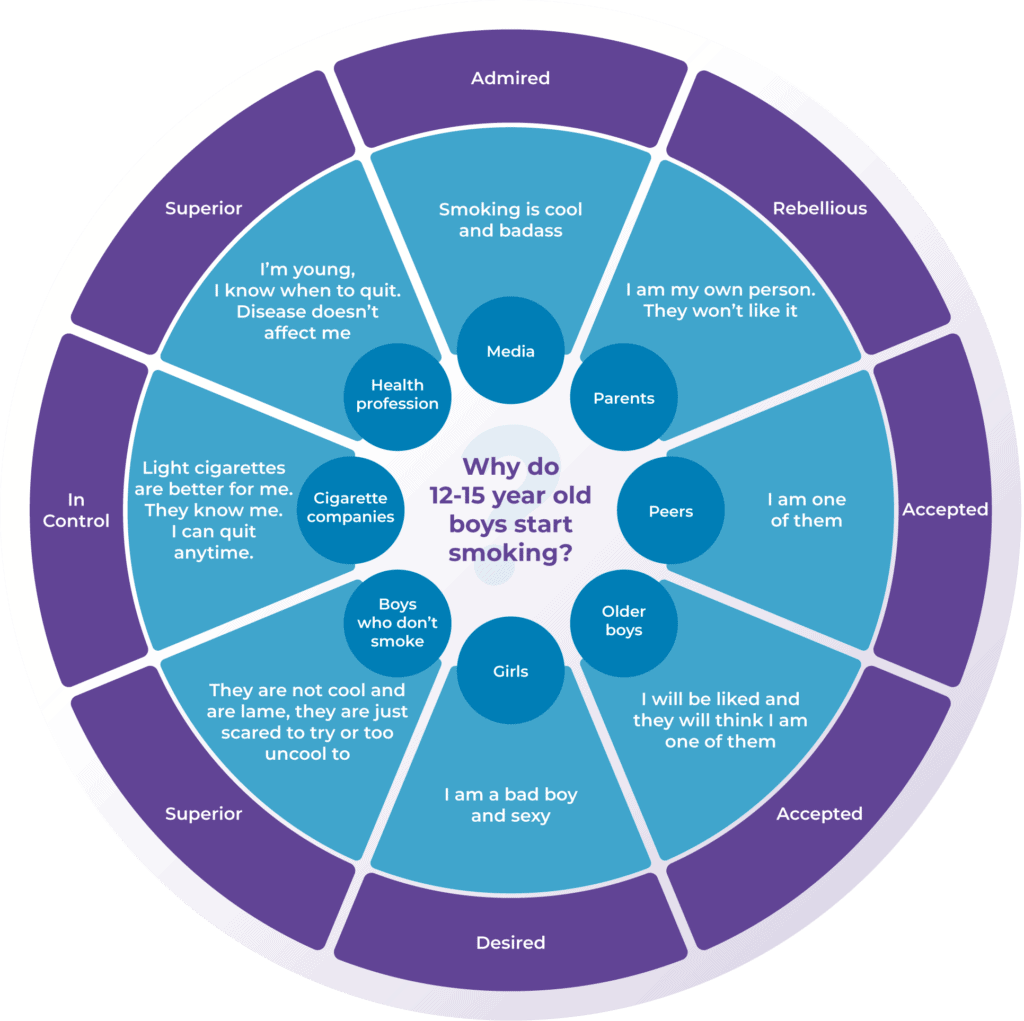Target Audience Statement
Who are you talking to? It may seem like a simple question, but it is one of the questions many communicators struggle to answer. Campaigners and NGOs will often say “everyone” or spin out a very broad target audience statement.
As the media becomes more segmented, knowing exactly whom you are speaking to is essential. In the digital world there is an emphasis on putting the audience first, not the media. With the rise of social media, it has become essential to reach your ideal target audience. This is called a micro target audience: a hyper segmented audience you can truly make an impact on to create behavioural change.
This mapping technique is based on one used by many marketing organisations originally developed to move people to purchase products and services (traditional marketing). However, the map has applications for all communication including behavioural change through counter – and alternative narratives. This technique helps you identify:
- An attitude, behaviour, skill or knowledge gap in your audience
- Influencers for your audience
- Their beliefs about current behaviour, attitude or knowledge
- Emotional motivators
Broad Target Audiences
Broad target audiences have been a staple of media and communications for decades. Broadcasters use these to segment their shows, publications and articles. Typically, a broad target audience is based on demographics and geographical information.
Demographic Information (I) | Demographic Information (II) | Geographic Information |
Age | Occupation | Resources |
Gender | Religion | Cultures |
Ethnicity | Nationality | Neighbourhoods |
Income | Lifecycle | City |
Qualification | Language | Region |
Marital Status | Race | Countries |
Sexuality | Media Use | Climate |
The above target audience for a Television programme in South Africa is typical of a Broad Target Audience. There are however immediate problems with having an audience this broad. While there will be some content that appeals to all in this group, a vast majority of things differ. Consider just the level of language and language complexity the hosts would use to appeal to a 14 year old versus that which would appeal to a 24 year old. While one part of the audience is entering high school, the later part of the audience is exiting university.
We can tell a great deal about a person simply by examining the demographic data about their life – their age, income level, education, occupation – but by itself, this data is only of limited use. It tells us nothing about their aspirations, their beliefs, their attitudes, or any other subjective psychological measure. Defining your broad target audience is the starting point. It is your first distillation of your audience. The next step will be to refine this audience even further.
Specific Target Audiences
Once you have defined a broad target audience, the next step is to create a specific target audience. To do this we use a mapping technique. Starting with a target question in which we identify a behaviour, we then examine the question through those that influence it, the beliefs about the behaviour or attitude and finally the emotional driver behind the audience’s behaviour.
Once we have discovered who the audience is that we are talking to, we can then develop strategies on how to influence this group through entertainment, campaigns or communication. As stated previously, the map is based on a behaviour change model. It requires the identification of a behaviour in the target audience. Once we discover why the audience has this behaviour, through understanding their beliefs, influencers and emotional drivers we can then bring them new knowledge, skills or attitudes to change it or shift it. The map uses a number of concentric circles from the Target Question.

The Target Question
At the centre of the map is a Target Question. A target question is a question related to behaviour. It starts with WHY? The more specific the question is, the better your map will be.
Your broad target audience is a good starting point. Now identify a smaller segment. To formulate a target question you need to use the following equation:
Why does… Community + Freely Chosen Behavior
Community
A community is a group of people who share a similar belief. “Teenagers”, “Mothers”, “Muslims” are all communities. Consider the number of communities you belong to. This may include many of the demographics and geographic you listed in your broad target audience statement.
What is necessary is that their motivation for doing something must be the same. There will often be a gender difference in reasoning, for example women may choose different reasoning to men for the same behaviour.
Freely Chosen Behaviours
A freely chosen behaviour is any behaviour the audience does at will. The community group are not forced to do it, they chose to do it. While many people think tradition and religion are not freely chosen behaviours, they are indeed. One may choose to celebrate religious festivals or observe religious traditions.
When a behaviour is not freely chosen, then it is necessary to discover whose behaviour is freely chosen. For example, why do Saudi Arabian women not drive? Until 2018, it was illegal for women to drive cars. Their behaviour was not freely chosen. It is therefore necessary to map “Why do Saudi lawmakers prevent women from driving?”
Target Question Examples:
WHY DO…
Community | Freely chosen behaviour |
Young mothers in Europe | Rarely breastfeed in public? |
Young European first generation Muslims | Join Isis? |
Jewish Americans | Circumcise their sons? |
Mid-western African Americans | Reduce their salt intake, despite their high-risk status for hypertension? |
Eastern European University students | Share fake news articles? |
Nigerian University students | Join cult groups? |
Ugandan male teenagers | Reject using condoms? |
Chinese parents | Use marriage markets to find spouses for their children? |
Influencers
In the second concentric circle, you should list the major communities or influencers that influence the behaviour or belief. There are the people/things that the community that you have stated in your target question are influenced by. Always include their peers (peer group pressure), culture, image, money, gender, sex, opposing views. Who are the experts for this group? Who are their celebrities? Each influencer gets their own slice of the map.

If you examine the map, you will notice that the map includes both positive and negative influences on behaviour. “Parents”, “Health Profession” and “Boys who don’t smoke” all may influence the “start smoking” behaviour as negative. It is important to include them in the map as they still have influence on behaviour.
Influencers such as the media are also included in the map. There may be dominant ideas that the target audience receives from the media about their behaviour. If you know specific celebrities that are relevant to your audience, include them in influencers.
Agreed Realities
An agreed reality is the belief that the community in the middle of the map has about how the influencer views their behaviour. Think about it as if you were looking from their point of view. It is not the reality of the influencer but the reality the target question community has based on the influencer. In the example of “Why do some teenage boys smoke cigarettes?” an important influencer for teenage boys will be their peers (other teenage boys who smoke). By smoking, teenage boys will think that their peers believe them to be “one of us” or their belief could be that they are “cool”.
When examining agreed realities, always approach it from the perspective of the target community in the centre of the map. It is good to use common phrases or slang words that your audience would use in the explanation of their beliefs. These are often mantras that are shortcuts to why they believe what they do and these can be challenged through new knowledge, skills or attitudes.
In the map below, the decision to start smoking has a number of agreed realities for young men. These are included below. You can add a lot more influencers and agreed realities as you discover you are missing important influencers or in talking with your target audience to understand their beliefs.

Gaps in Knowledge or Skills
It may become apparent that there is a gap in knowledge or there is a belief that demonstrates a skill is required. For instance, young women don’t use female condoms because they don’t know how they work. You should include these in your map. The Agreed Reality is “Don’t know how they work” or “Never tried it”.
Feelings of Emotional Payoffs
Emotions are essential in understanding behaviour. It is not true that logic is responsible for our decision-making; rather it is emotion that is the biggest driver. It is therefore necessary to understand what our audience feels about the behaviour in relation to the influencer.
In each slice of the map, you should correspond to an emotional driver or emotional payoff. Below is a list of both positive and negative emotional payoffs. The reason why we do something is that it makes us feel good or makes us have a positive reaction. Humans avoid feeling negative emotions.
Inferior | Joyful | Guilty | Shameful | Disgusted | Angry | Annoyed |
Superior | Admired | Free | Proud | Loved | Adored | Hopeful |
Hated | In control | Powerless | Feared | Fearful | Rebellious | Desired |
Passionate | Embarrassed | Compassionate | Affectionate | Energized | Irritated | Frustrated |
Lonely | Sad | Hurt | Desired | Compassionate | Regretful | Alienated |
Nervous | Lust | Contempt | Relieved | Surprised | Bitterness | Envious |
Jealous | Terror | Panicked | Aroused | Sentimental | Needed | Trusted |

Research
Maps require research – some of which you have already done in your context analysis. The best form of research is to interview or listen to your target community for their agreed realities and emotional payoffs. Social listening is a great resource to discover the agreed realities and emotional payoffs of your target community. By exploring statements, tweets, images, expressions and comments made by your target community or their influencers on the topic you can develop a more rounded view of your map. This can include words or phrases that your audience use or understand.
Formulating a Target Audience Statement
A target audience statement is the reading of the Map from the Target question to the feelings or emotional payoffs. It does not assume that you will reach everyone, that’s why we start the statement with the word “some”. Each slice of the map will present you with a different target audience.
In the example of the Cigarette Smoking map above the target audience statement:
- PEERS: Some teenage boys believe smoking makes their peers think they’re cool, and one of them, and that makes them feel accepted.
- GIRLS: Some teenage boys believe smoking makes girls think they’re ‘a bad boy’ who is sexy and that makes them feel desired.
For your campaign you should pick the slice, you know you can have the most or most realistic impact on.
Exercise: Look at your chosen target audience by using a social media platform of your choice (Facebook, Instagram, Twitter, Youtube, etc.). Mine your chosen community and their agreed realities to complete one slice of the map. Do some research on some of the agreed realities by using your laptop/tablet/smartphone. Focus on language use, slang, cultural symbols and statements. Click below to access the template for your exercise.
Exercise: Create your own map. 1. Start with a target question for the campaign you want to build. 2. Identify up to 8 influencers of your target audience. 3. Complete the map by filling in the agreed realities and emotional payoffs (you can use social media to mine this information).

